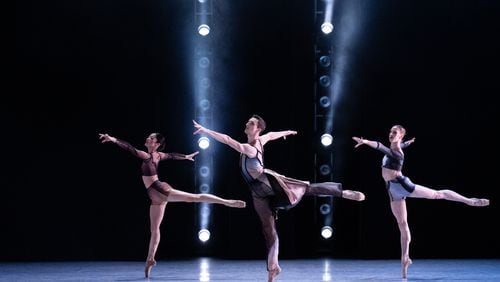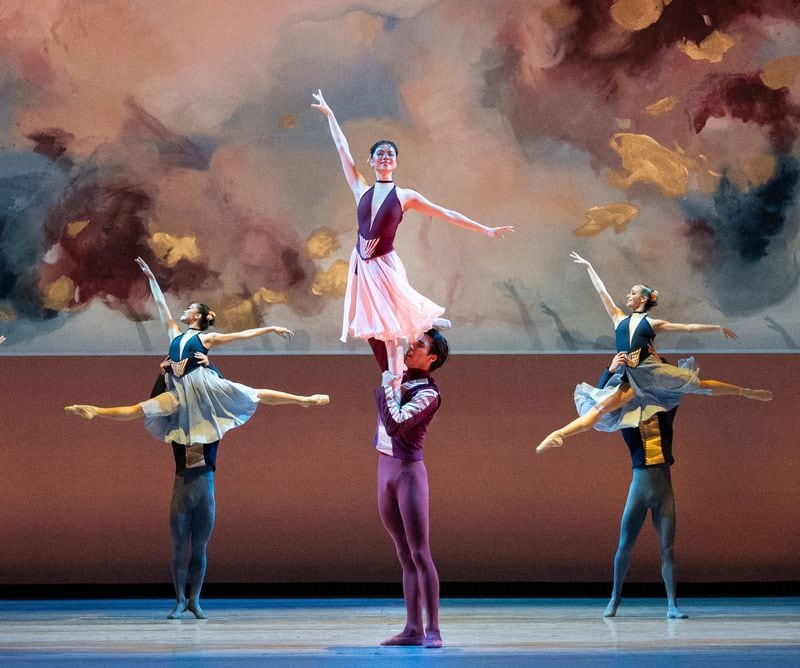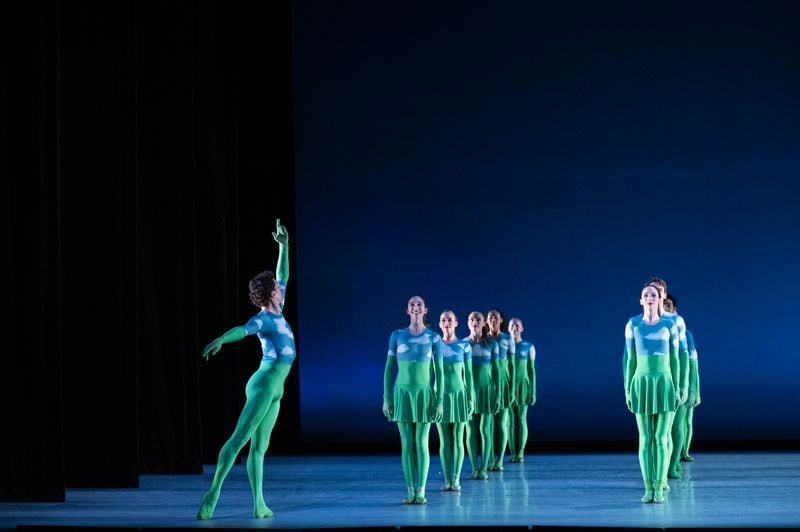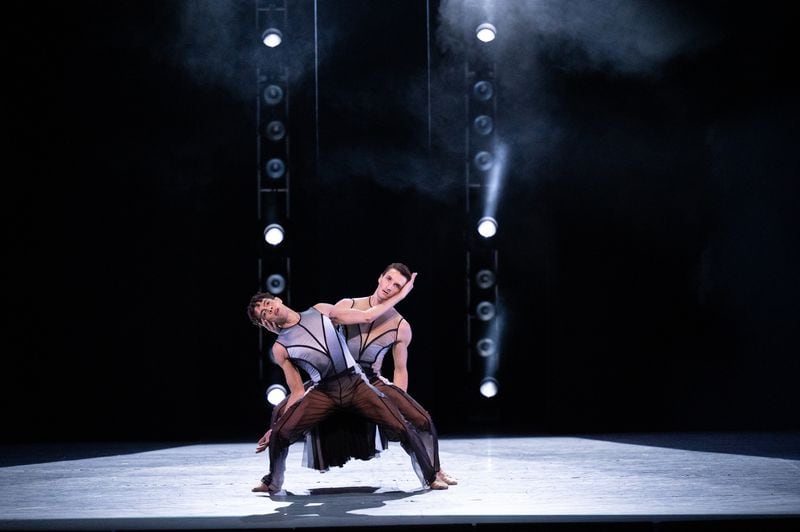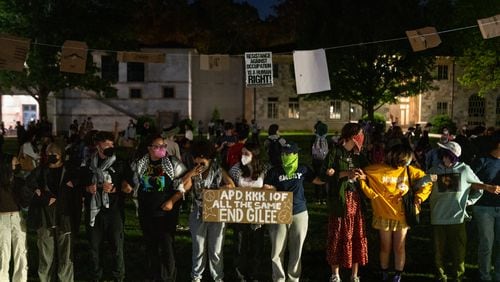This story was originally published by ArtsATL.
Atlanta Ballet’s “Kaleidoscope,” presented at the Cobb Energy Performing Arts Centre on March 22-24, offered a pastiche of fluff and substance through two world premieres and a restaged work from 1999. These stylized, opposing worlds opened a door to consider what imprints itself as memorable and what dissolves away. The ultimate takeaway from Friday’s performance was a manifest on the emptiness of temporal beauty, and how such beauty can wilt behind a welcomed menacing of the inexplicable.
“Kaleidoscope” opened gently and ended with a bang with Garrett Smith’s new work “Corridors,” underscoring the delicate nature of programming a mixed bill.
Credit: Shoccara Marcus
Credit: Shoccara Marcus
Sergio Masero, a dancer with Atlanta Ballet, presented the opener, “Querencia” (Spanish for desire). It is his third work for the company. The piece was a heaping dose of lovely. A lovely painting mottled with gold, royal blue and maroon loomed as a backdrop to similarly dressed dancers in lovely romantic costumes. Were the dancers melting away from the painting or being folded into it? Music by Anton Arensky, elegantly played by Western-Li Summerton, Lisa Morrison and Charae Krueger, provided the sonic foreground that would sporadically make its presence known.
A musing on joy, comfort and strength (according to the choreographer), “Querencia” is a meaningful showcase for the 10 dancers who commanded the stage with complicated lifts — often performed in unison — powerful jumps and polished brisés. The men looked secure and strong, fearlessly launching themselves into double tours with efficiency and power.
Of particular note, female lead Mikaela Santos was riveting in her delivery of exquisitely difficult material. Her partner, Munkhjin Ulziijargal, possessed equally impressive technical range, yet the implied romantic inclinations were caged in by his arrested torso and tense shoulders. This slight imbalance required Santos to carry the narrative for a somewhat clichéd love affair — the most discernible reference to Masero’s stated intentions for the work.
He has created a solid, yet thin, neoclassical ballet. For the duration of this 20-minute piece, the movement rarely veered from the opening idea of geometric patterns decorated with breezy duets. Whether intentional or not, this stasis created a longing in the viewer for more tension, the elongation of an idea, more complexity. The flurry of entrances and exits seemed to have little structural motivation aside from reorganizing dancers when off stage, only to return with little new to say.
The most memorable moment came midway when one male dancer entered the space in silence, then one by one, three more male dancers entered, still in silence, joining the first dancer in the challenging material. The movement was slick, compelling and self-assured.
Credit: Shoccara Marcus
Credit: Shoccara Marcus
When Mark Morris’ “Sandpaper Ballet” was created in 1999 for the San Francisco Ballet, the process granted Morris the opportunity to wallow in the choreographic possibilities of a large cast, 25 dancers in all. In classic Morris form, the piece pokes lighthearted fun at familiar conventions in dance and music, while not taking itself too seriously. Sing-songy melodies by Leroy Anderson, of Boston Pops and “Sleigh Ride” fame, paved the way for the work, while the dancers were clad in highlighter-green bottoms and cloudscape tops, designed by Isaac Mizrahi.
A lingering question is: Why this dance? Why now? (Atlanta Ballet last performed it in March 2019.) Replete with outdated tropes and a barrage of G-rated “cuteness,” this work stilted the dancers.
Almost consistently, each new musical selection was framed by dancers constructing a five-by-five-person grid. From here, the grid would break down into smaller groups which then peddled predictable material, with half-hearted, gleeful abandon. It was an ode to similitude. Images of tap dancing, dancers mugging for the audience and the “Oops I’m in the wrong spot” schtick fell flat, due in part to a sense that the dancers didn’t seem to believe themselves.
Garrett Smith’s “Corridors,” a world premiere created specifically for Atlanta Ballet, adeptly answered the call for what had otherwise been absent from the evening. The work is rich with nuance, tension, drama and exhilaration. Deep physicality, soaring virtuosity and rendered emotional output coalesced to deliver a work whose meaning was deliciously just out of reach. One was asked to feel and sense the work minus the labor of translating it intellectually.
Yearning without being wistful, and narrative without being pedantic, Smith’s ballet for nine stellar dancers evoked a futuristic world of mesmerizing connectivity, ethereal flight and fragile interpersonal connection. Lighting designer Ben Rawson soared to new interpretive heights with stunning design concepts that placed this dance in an unidentifiable time and place. At one point, technology and movement shared equal impact as dancers engaged in a provocative unison statement while light looks changed every eight beats, redefining the space, shifting the architecture.
Credit: Shoccara Marcus
Credit: Shoccara Marcus
Jordan Leeper and Marius Morawski were the evening’s astounding standouts as this work became a vehicle for their striking capabilities. With the allure of a siren’s song, they collided, intertwined, consoled and taunted each other with latent affection and disdain. Was this connection real, or did it exist in their imaginations? Intense dedication to authenticity and power grounded the duo with such authority that even when the dancers were apart or absent from the stage, the residue of their connectivity remained in the air like a haze — governing the space, divining an empathetic desire to know more about them.
In another remarkable section, dancers were lifted and flown around the space, diving and ascending with silky grace. Even those who were manipulating the elevated dancer(s) were magnificent to watch. The support system seemed to also glide across the floor, as though they themselves were being carried by the wind.
Moments like this revealed how strength can give way to intoxicating lightness and simultaneously revealed Smith’s attention to detail.
The music as well as the costumes felt a bit “on the nose,” evocative of the “Waterworld”-”Thunderdome” genre of films. Peter Gregson’s pulpy cinematic and often grand orchestral score coupled with copper, ivory and black costumes, embellished with half-skirts for the men, dated the work.
Still, this urgent piece is nonetheless a lesson in collaboration; a gift for the eyes, a commentary on isolation of the heart.
As the ensemble returned to moving along defined pathways of light, going everywhere and nowhere, Leeper and Morawski cast one final look toward each other as the curtain lowered. While this moment was oddly literal and a touch out of place — perhaps even an easy way out — it was an encapsulation of the work’s unspoken and encrypted message . . . we hunger to be seen, we hunger to be remembered.
::
Born in Tehran, Iran, George Staib is of Armenian descent. He has lived in the United States since the age of ten, when his family was forced to flee the Iranian Revolution. He is the artistic director of staibdance and a professor of practice in the dance program at Emory University.
Credit: ArtsATL
Credit: ArtsATL
MEET OUR PARTNER
ArtsATL (artsatl.org) is a nonprofit organization that plays a critical role in educating and informing audiences about metro Atlanta’s arts and culture. ArtsATL, founded in 2009, helps build a sustainable arts community contributing to the economic and cultural health of the city.
If you have any questions about this partnership or others, please contact Senior Manager of Partnerships Nicole Williams at nicole.williams@ajc.com.
About the Author
